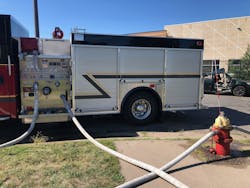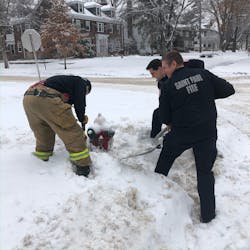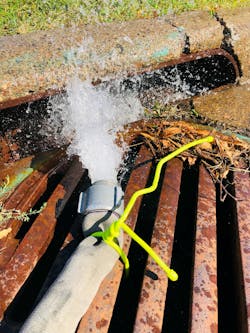Cold weather can seriously hamper fire attack efforts. It can affect everything from the apparatus to attack lines to members’ footing. In most jurisdictions, fire duty seems to increase as the temperature drops.
Whether your climate has sustained cold weather or simply cold snaps, plans must be in place to minimize the effects on the fireground.Preparation
As with any time of year, it’s important to know the weather forecast. As the temperature begins to drop, supplies should be placed on the apparatus to help to ensure the safety and comfort of members.
Freezing temperatures can quickly turn the fireground into a skating rink, causing members to slip and fall. Buckets of sand and/or salt should be placed on the apparatus. Spreading sand and/or salt on scene is a simple precaution to help to avoid injuries, particularly for apparatus operators, who often encounter ice that built up around the engine.
For longer-duration incidents, public works may need to respond with salt trucks.
Members should place cold-weather bags on the apparatus. A typical cold-weather bag consists of gloves, hoods, socks, T-shirts, chemical hand warmers and winter hats. Having dry equipment to change into can minimize the discomfort on prolonged incidents or when responding from one incident to the next.
Pumps: Wet or dry?
Departments must consider how they store their pumps. The two options are wet or dry, and they both have advantages and disadvantages.
Departments must weigh their options and consider jurisdiction-specific factors, such as response times, the durations of runs and nonfire uses of the apparatus. Departments must adopt a standardized approach to ensure fireground function and to prevent damage to the pump.
Many departments opt to run wet pumps year-round. Wet pumps are a simple option, because members are used to operating that way in warmer weather. That said, directives must be in place to recirculate water in the pump while on scene or while exposed to the elements when the temperature drops below a designated level. The process involves simply opening the tank-to-pump valve, partially opening the tank refill valve and placing the apparatus in “pump.”
The advantages to this method include not having to drain the pump; members don’t wrongly assume the pump is dry; and there’s no delay/need to prime the pump when on scene.
The major disadvantages include the potential for water to freeze prior to arrival at a fire and members forgetting to recirculate water when exposed to cold temperatures.
In theory, dry pumps have the advantage of no water being in the pump that can freeze. This might be critical for departments that have long distances to travel as part of their response area. During these long responses, particularly in extremely cold conditions, water in the pump can freeze prior to arrival.
There are several disadvantages to running a dry pump. The major concern is the pump not being fully drained or a leaky tank-to-pump valve. If methodical care and maintenance isn’t taken, members will wrongly assume that the pump is dry when it isn’t. This assumption can cause the pump body to freeze and crack or the pump not to function on the fireground. A small amount of water can be worse than a pump full of water, because a small amount freezes more quickly than a full pump does.
Care must be taken to ensure that valves don’t leak, that the pump is fully drained and that the main drain is opened periodically to confirm that the pump is dry.
Apparatus manufacturers offer additional cold-weather pump options, such as pump house heaters and belly pans. Department’s must analyze their response area’s climate to see whether these are worthwhile additions to their specs.
Pump heaters are supplemental heater cores/elements that are installed in the upper area of the pump house. These heaters help to keep the small-diameter lines that go to the gauges from freezing. The heaters do little to prevent the water that’s in the pump from freezing.
Belly pans, or heat shields, are removeable metal sheets that are installed at the bottom of the pump house. When specced properly, the engine exhaust runs above the belly pans in the pump house. The metal pans reflect and retain the heat from the exhaust.
Plumbing
Because the majority of discharge plumbing is located past the valve—or before the valve in the case of intakes—recirculating water in the pump does little to prevent any water in these pipes from freezing.
Drains for all discharges and intakes should be opened periodically, including after each use, to ensure that no water is in the piping. Once the water stops draining, the drain should be closed to keep it from potentially freezing in the open position.
Caps that are on intakes and discharges should be removed periodically to ensure that no water is retained in the piping, particularly in the elbows.
Water supply
Obtaining a positive source of water can be difficult during the wintertime. In particuar, hydrants can be frozen or buried in snow, which hinders operations.
Having hydrant maps can make locating a buried hydrant easier as well as aid in finding the next closest operational hydrant in a case when the selected hydrant is out of service.
Members should shovel out hydrants in their district when heavy snowfall occurs. Shovels should be easily accessible on the apparatus in case hydrants must be shoveled out when on scene.
With the high probability of a frozen or buried hydrant, engine company officers should be prepared for the likelihood of operating off tank water for a longer duration than typically and plan their attack accordingly. Incident commanders (ICs) must consider additional resources early in the incident if the hydrant is out of service or buried. Additional engine companies might be needed to establish a relay from the nearest operational hydrant.
Some departments opt for specialty thawing equipment for hydrants, for exammple, a propane torch that’s used to warm the hydrant and melt the accumulated ice. A road flare is a more readably available, albeit slower, option.
If the hydrant barrel isn’t completely frozen—thus, blocking the discharges—circulating warm tank water through the hydrant is a quicker option than using thawing equipment. This is done by hooking from an apparatus discharge to a discharge on the hydrant and hooking from a second hydrant discharge to an intake on the apparatus. Water is then pumped through the hydrant, which causes it to thaw.
It’s important to remember that none of these options is fast, and a more distant water supply should be considered the primary option.
Dump lines are additional water supply safety concerns. When hooked to a hydrant and the tank fill valve is in the open position, the tank will overflow once full. In warm weather, this isn’t a serious concern, but in the cold, it quickly creates an ice rink around the apparatus. The remedy isn’t as simple as closing the tank fill valve when the tank is full, because water must continue to circulate to keep the pump and supply lines from freezing. A dump line can be used to alleviate this problem. The dump line is simply a booster line or length of hose that’s run to a yard or nearby sewer to allow water to move through the system.
Fire attack
Fires during the wintertime might be larger on arrival than is the case during warm weather as a result of slower travel speeds that are required to arrive safely. Hose stretches can take longer as a result of snow and ice. Smaller-diameter handlines freeze faster, which can hamper suppression operations.
Members must be prepared for partially or completely frozen handlines. With smooth bore nozzles, the ice often simply passes through the orifice. With fog nozzles, the pattern selector might have to be turned to the flush position to allow the ice to pass.For larger ice pieces, water flow passing by the ice often is enough to melt them.
With the potential for ice to obstruct the attack line, backup lines should be a high priority in particularly frigid conditions.
Similar to pumps and supply lines, water must flow to prevent the hose and/or nozzle from freezing. The bale of the nozzle should be kept partially open to allow water to flow when the line isn’t in use for prolonged periods. The nozzle can be placed in a sink or bathtub or out an open window to prevent water damage.
After the fire
Once the fire is extinguished and the IC begins to release companies, attack lines should be shut off and drained to prevent freezing. After draining, while still pliable, the hose should quickly be folded for transport back to the firehouse or loaded back on the apparatus. Nozzles should be opened to drain any water that might remain in the ball valve to prevent freezing and potential damage or malfunction.
The water supply should be shut down, and supply hose should be treated in the same manner as the attack hose.
After the hydrant is shut and hoses are disconnected, members should place an ungloved hand over a discharge to ensure that the dry hydrant is draining properly. Follow your department’s procedure, or notify the water department, if there are concerns about the hydrant not draining.
Fire pumps should be left to recirculate on scene while the companies pick up. Drains for inlets and discharges should be opened, and water should be drained. It’s important to remember to close these once the water stops draining.
Caps on inlets and discharges should be removed to ensure that no water built up behind the caps. The final step: Restore the pump to the method the department has selected, wet or dry.
Prepare
Cold weather can present serious hazards that can greatly impede operations if members aren’t prepared. Departments must analyze their climate, response area and equipment to determine the best cold-weather procedures to adopt. Engine company personnel must be diligent with inspections of their equipment, response district and following best practices on the fireground. As always, companies must train and find solutions to worst-case cold-weather scenarios.
About the Author

Jonathan Hall
Jonathan Hall, who is a Firehouse contributing editor, has more than 24 years of fire service experience. He currently is a captain with the St. Paul, MN, Fire Department assigned to Engine Company 14. Hall also serves as a lead instructor in the department's Training Division; he teaches hands-on skills to members of all ranks. Hall is the co-owner of Make The Move Training LLC and teaches engine company operations throughout the country.



